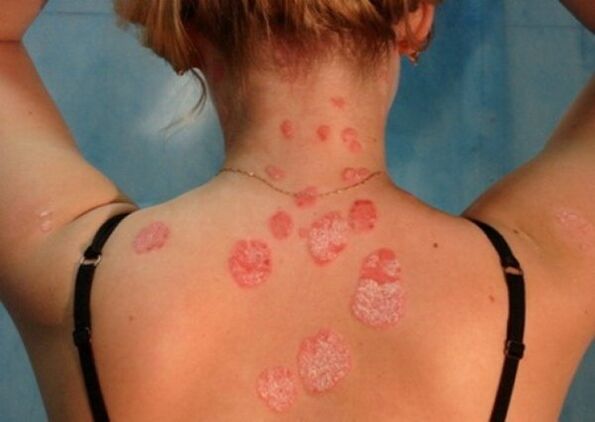
Psoriasis (also known as scaly lichen) is a non-infectious chronic and recurrent skin disease.
Psoriasis, whose symptoms determine its tendency to damage periarticular tissues, manifests itself in the form of scaly papules, in addition, it is worth noting that this disease is one of the most common skin lesions that occur at any age.
The etiology of this disease has not yet been fully studied and proven, but many dermatologists still agree that psoriasis is a disease directly related to genetic inherited pathologies.
Do not self-medicate. At the first signs of illness, see your doctor.
general description
Psoriasis is characterized by the duration and permanence of its own course. His remissions, which can be several months or several years, meanwhile show his subsequent return and life expectancy. Spontaneous cure of this disease is extremely rare.
If you try to identify a specific category of people prone to psoriasis, then the solution will not be unequivocal. The fact is that psoriasis, acting as a systemic process, develops not only in people with real immune disorders, but also in people who have certain functional or morphological disorders related to the functions of various systems and organs.
Belonging to the group of dermatoses, psoriasis is one of the most studied diseases in them. Meanwhile, none of the hypotheses available today can fully determine the nature of this disease. Given this, the problems associated with its therapy and prevention are in the same precarious and at the same time acute situation as before. Depending on the specific time period, different ideas about the origin of psoriasis are proposed. This in turn led to the choice of a number of forms, each of which is based on the results of certain laboratory tests and clinical observations.
- The hereditary nature of the disease. This suggests the presence of psoriasis in several generations, in which cases of this disease have been reported. By the way, heredity is considered in practice the main and reliable cause of the development of psoriasis (in this case, psoriasis increases under the influence of various types of provoking factors).
- The metabolic nature of the disease. In this case we mean disorders in fat metabolism (ie in cholesterol metabolism), reduced morbidity during periods of starvation, increased phosphorus in psoriatic scales and others.
- The viral nature of the disease. In this case, the concept of direct involvement of viral infection in the etiology of the disease in question is formed on the basis of numerous and long-term clinical observations. Accordingly, for the same reason, the infectious (and viral) nature as a theory of the development of psoriasis is the most ancient. Thus, the end of the 19th century was marked by cases of the formation of very large groups of psoriatic-type formations, formed against the background of patients suffering from diseases such as scarlet fever and influenza. The systemic nature of the actual lesion, its recurrent and prolonged course, the presence of a link with meteorological and heliophysical factors, and some features inherent in the evolution of rashes characteristic of psoriasis also acted as confirmation of the infectious nature of psoriasis. disease. As far as we are concerned, we are currently looking for those viral agents that can trigger the psoriatic process.
- The endocrine nature of the disease. The theory of a direct link between the appearance of psoriasis and the endocrine (as well as metabolic) nature in the recent past has been supported by many. Examination of patients with psoriasis often reveals certain disorders of the endocrine scale, which serves as a justification for the appropriateness of such a relationship. In particular, the disorders related to the functional state inherent in the gonads, the influence caused by the menstrual cycle, pregnancy, childbirth and breastfeeding, the pronounced type of changes found in the study of the pituitary-adrenal system of patients were highlighted.
- The neurogenic nature of the disease. It occurs at the beginning of the disease against the background of nervous shock, which is relevant to the patient (more precisely, after it was transmitted). In about 30% of cases, the exacerbation of the disease occurs on the basis of stress. In this case, patients have a reduced ability to withstand the effects of stress and the subsequent transmission of its consequences. At the same time, the disorders they have (asthenic, vegetative-vascular-visceral, vegetative-vascular-dystonic and asthenodepressive) in combination with neurotic reactions provoke the formation or even exacerbate the characteristics of the prevailing vicious circle.
Classification
As already noted, psoriasis acts as a chronic and recurrent disease. Each of its existing forms can be attributed to one of the variants of the classification applicable to psoriasis, in which there is a distribution for pustular or non-pustular psoriasis. In general, the classification is as follows:
- Pustular psoriasis
- generalized psoriasis;
- annular psoriasis (annular pustulosis);
- palmoplantar psoriasis (psoriasis of the limbs, persistent palmoplantar pustulosis, barber pustular psoriasis);
- chronic form of persistent acrodermatitis (psoriasis of the feet and palms, palmar-plantar psoriasis);
- herpetiform psoriatic impetigo.
- Non-pustular psoriasis
- psoriasis vulgaris or psoriasis vulgaris, simple psoriasis (plaque, stable psoriasis in chronic form);
- psoriatic erythroderma (erythrodermic psoriasis).
A number of authors agree with the need to supplement this classification, which is why types or forms of psoriasis can be added to it in the following variants:
- seborrheic psoriasis (seborrheic psoriasis);
- Napkin psoriasis;
- drug-induced psoriasis;
- "Reversible psoriasis" (psoriasis of skin folds, flexor surfaces).
Psoriasis: symptoms
The first symptoms of psoriasis are miliary papule rashes, which are characterized by a gradual increase in the periphery, while transforming into numular and lenticular papules and merging with each other, resulting in plaques of various sizes. The development of psoriasis in the skin determines three main stages for it.
First stage
This stage is defined as a progressive stage, caused by the formation of new formations on the skin (actually papules), as well as an increase in the size of those formations that are already on the skin. This is also accompanied by the formation of an erythematous border around the lesions (such a border is defined as a zone of peripheral growth). The plaque on the edges is not susceptible to peeling, while peeling, acting as the last stage of inflammation, is not in step with the growth process of psoriatic formations.
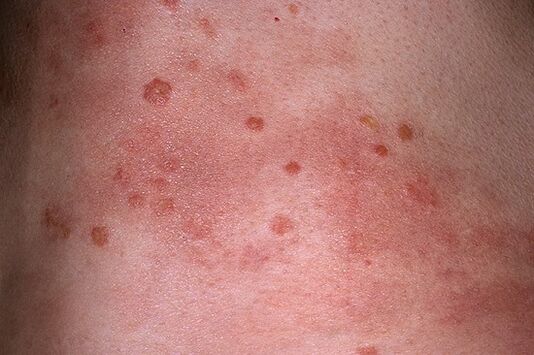
Second stage
The second stage defines a stationary period in which new elements do not appear, but the existing elements in the form of plaques and papules do not change in size. In principle, the appearance of papules can be completed at any stage, therefore the stationary period may be accompanied by the simultaneous appearance of miliary papules, lenticular and numular papules. Let's explain which are the three types of papules listed. Thus, numular papules are elements of a rounded skin rash with a diameter of 15-20 mm (for this reason, these papules are also called coin-shaped). Lenticular papules, in turn, are elements of a rash, flat or convex, oval or round in shape, resembling a lens. Finally, miliary papules that have a conical shape of the elements and thus are similar to hemp seeds. In general, these papules are small in size, the predominant area is close to the hair follicles.
Third stage
This stage is reversed (or regressive). Its main feature is that the rash gradually disappears, and a whitish pseudosclerotic border forms around the foci (defined as the Voronov edge). During this period, some patients may experience mild itching. As for any subjective sensations, they are mostly expressed insignificantly or even completely absent.
The appearance of rashes can be noted in any area of the skin, but they are localized mainly in the area of the surface of the curves of the limbs, especially in the elbow and knee joints, sacrum, scalp (here in particular distinguishes the area ofedge of hair growth, which is defined as "psoriatic crown"). Psoriasis on the head, whose symptoms, although determined by the severity of their own manifestations, do not lead to changes in hair structure, as well as to their loss.
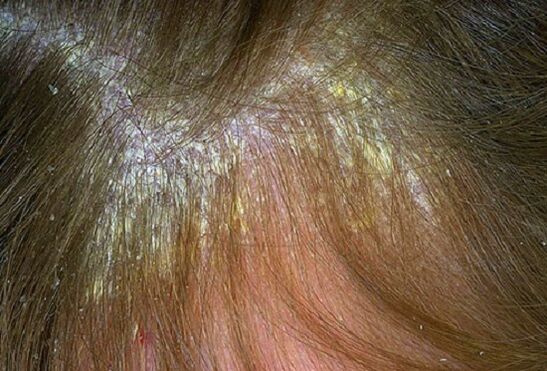
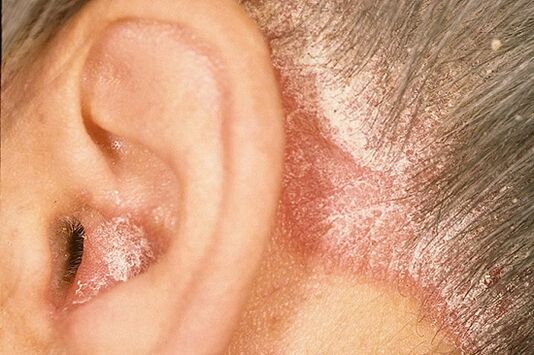
As for the concentration of plaques in the extensor surface of the knee and elbow joints, here they often persist for a long time from the moment the rash disappears in general (this characteristic defines them as "duty" plaques). Some patients facethe fact that skin folds are affected in the groin or mammary glands, as well as in the axillary glands and often such a lesion can be isolated.
Irritated psoriasis
It develops against the background of active exposure of the skin with pre-existing progressive psoriasis to certain irritants, in particular sunlight or specific ointments, as well as other types of irritants that affect plaques. These plaques, in turn, acquire a more convex shape, the color changes to cherry red, a hyperthermic belt is formed in the vicinity, due to which the sharp boundaries become somewhat blurred. This belt, after the separation of the poster, acquires a wrinkled appearance.
Spotted psoriasis
This form of the disease manifests itself in the form of mild infiltration (in the general definition infiltration is the impregnation of tissues with one or another substance) of the elements of the rash. They in turn look like spots (not papules). Spot psoriasis develops, as a rule, acutely and is also characterized by a resemblance to toxicermia. The main method in the differentiation of the disease is the determination of the correspondence of the course of the disease with its characteristic psoriatic triad.
Old psoriasis
This form of the disease can be considered in terms of symptoms in the form of severe infiltration by plaques, their general cyanosis, with a hyperkeratotic or warty surface. This type of outbreak is particularly difficult to treat and it is possible that it may turn into a malignant tumor in the future (this is rare, but, unfortunately, it is not necessary to rule out this option).
Seborrheic psoriasis
This form of psoriasis, as its name suggests, develops in patients with seborrhea, which is already relevant to them. The disease is manifested by the scalp, the area behind the earlobes, the chest, the nasolabial folds, the subscapular and scapular parts of the back. Emerging psoriatic scales are subjected to intense saturation with sebum, due to which they stick together and remain in the surfaces of the plaques, thus allowing the disease to simulate a picture characteristic of seborrheic eczema.
Palmar-plantar psoriasis
The disease can manifest itself either in the form of ordinary psoriatic plaques and papules, or in the form of hyperkeratotic formations that simulate calluses and calluses. In some cases, psoriasis on the hands, the symptoms of which are noted in this case on the palms (or feet - by definition, on the feet) is continuous, which manifests itself in the form of increased thickening or keratinization. The boundaries of this type of lesion are characterized by clarity, in rare cases this form of psoriasis is limited to the appearance of large-ring peeling.
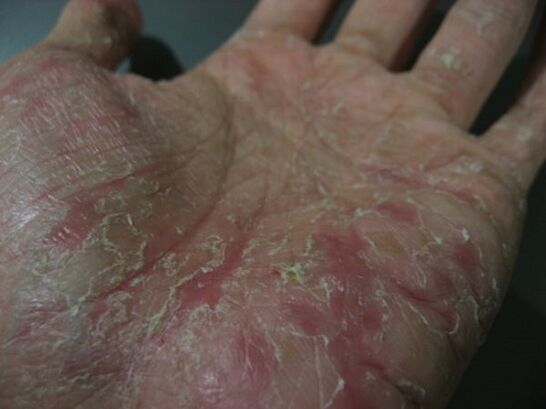
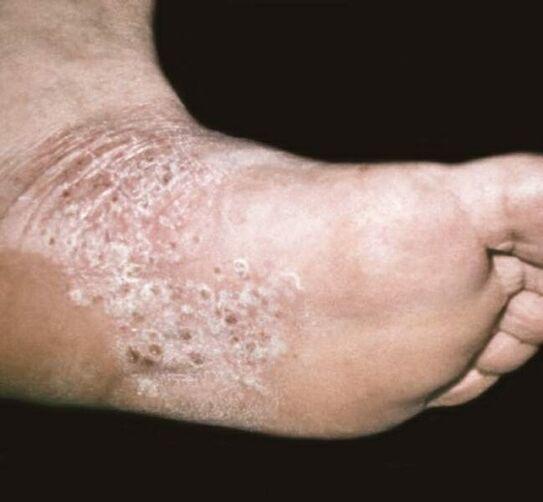
Exudative psoriasis
This form of psoriasis is characterized by excessive exudate during the inflammatory reaction; it occurs in the progressive period of psoriasis. Making its way to the surface of the papule, the exudate provides saturation of the accumulation of scales, thus forming from them formations that look like crusts. These elements are secondary, they are defined as crust scales, the color of these elements is yellowish. After their removal, a slightly bleeding and weeping surface is exposed. The scales, when dried and layered, often form a massive type of oyster-like conglomerate (this is now defined as rupoid psoriasis).
Guttate psoriasis
Guttate psoriasis, the symptoms of which appear suddenly, is characterized by the formation of numerous spots in the skin. The disease is most often diagnosed in patients aged 8 to 16 years. Often, streptococcal infection acts as a precursor to psoriasis.
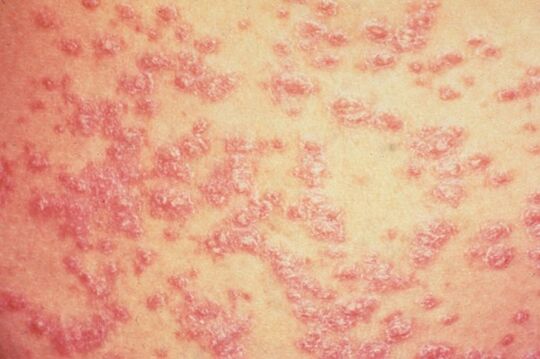
Nail psoriasis
Nail psoriasis, the symptoms of which provide the isolation of this type of psoriasis in three main forms, depending on the degree of damage to the nail, it can be atrophic, punctate or hypertrophic.
The punctate lesion is considered to be the formation of punctate depressions on the nail plates, which can also be compared to the surface of the thimble. The manifestation of this form of psoriasis is possible in a slightly different variant, which in its specificity is similar to onychomycosis. In this case, within the free edge, the nail plate changes color, becomes dull, prone to disintegration without much effort. An inflammatory border formed on the periphery of the affected area of the nail plate is defined as a sign that makes it possible to differentiate psoriasis. It appears as the edge of a papule in the nail bed, visible through the nail plate.
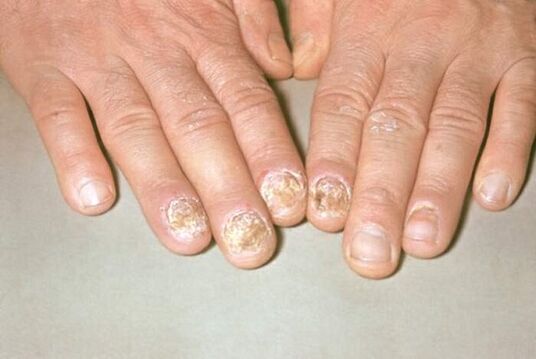
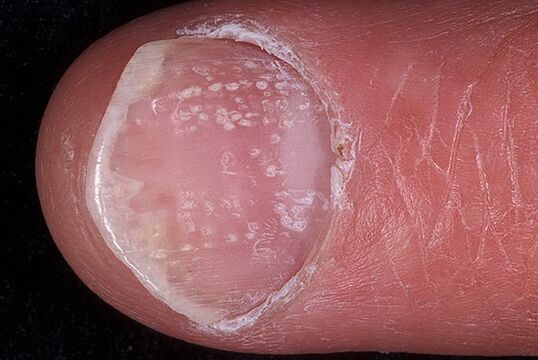
Psoriatic (psoriasis) arthritis
Psoriatic arthritis, the symptoms of which are due to infiltration involving periarticular tissues with concomitant joint damage, mainly affects the interphalangeal joints. Meanwhile, the possibility of involving large joints in the pathological process is not excluded, the joints and articulations of the sacroiliac spine are extremely rarely endangered in this regard.
It is important to keep in mind that psoriatic arthritis, unlike other types of arthritis (which by definition means inflammation of the joints), occurs against the background of a psoriatic rash that already exists in the patient, often combined with nail damage. . In addition, an important point can be noted that the appearance of this type of arthritis is combined with exacerbation of psoriasis in the skin, which in most cases becomes exudative.
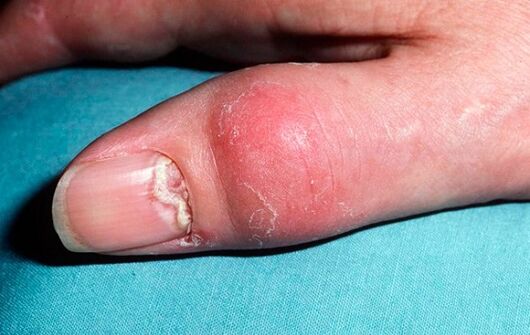
Irrational treatment of the disease during the period of its progression is often accompanied by the appearance of a nonspecific reaction from the body. It is toxic-allergic in nature and consists in the appearance of redness in the areas unaffected by psoriatic plaques, this redness, merging, completely affects the skin. This process is combined with fever (in the range of not more than 39 degrees), as well as enlarged lymph nodes, a feeling of tight skin, burning and itching. In frequent cases, there is abundant peeling, thickening and exfoliation of nail plates, hair loss. This picture already shows the importance of psoriatic erythroderma. Erythroderma ends with the restoration of the traditional version of the course of psoriasis.
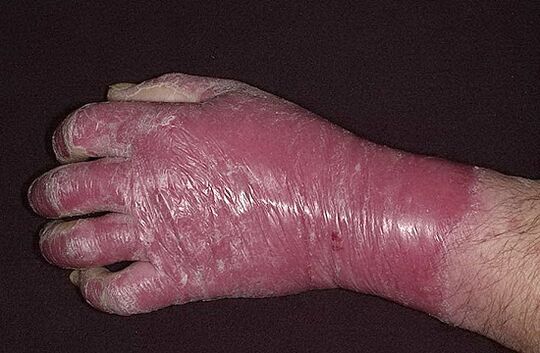
In general, recurrences of the disease occur during the autumn-winter period, as well as during the spring-summer periods, which is an important factor to consider, including when prescribing the necessary treatment.
Treatment of psoriasis
Before prescribing treatment, the patient is thoroughly examined and already to determine specific measures in it, they are based on the stage of the disease, its clinical variety, the general condition of the patient, the presence of comorbidities, the relevance of the disease. with seasonality, etc. , the fastest and at the same time a favorable result is achieved in the treatment of uncomplicated forms of psoriasis with their short course, as well as with limited manifestations. In general, the treatment of psoriasis is quite a laborious process and in most cases it is not possible to achieve a complete cure - the disease simply regresses (ie begins a period of its existence without symptoms), which, however, is also a positive result.
The main goal of treatment is definitely to suppress the symptoms as much as possible in combination with the addition of preventive measures.
First of all, psoriasis is prescribed a diet in which those foods that provoke an exacerbation of the disease (spicy foods, chocolate, alcoholic beverages) are excluded from the diet. The restriction also applies to the consumption of smoked meats, honey, fried and fatty foods, etc. In the period of exacerbation of the disease is recommended to eat more fruits and vegetables (except red: apples, tomatoes, cherries, etc. ), fish and lean meats (cooked).
The course of psoriasis has a beneficial effect on its treatment in the conditions of sanitary facilities. Given the special sensitivity of the skin in patients with psoriasis, it is recommended to avoid sun exposure on it in the period from 11 to 16 hours.
As for the medical treatment of psoriasis, it is based on the use of several methods. First of all, these are external means (creams, ointments, etc. ), drugs for systemic treatment (injections, pills, etc. ) and methods such as phytochemotherapy (phytotherapy), physiotherapy and others. methods of external treatment. In particular, the following drugs are most commonly used:
- Salicylic ointment. It provides softening of the formed scales, which in turn provides an opportunity for their early elimination along with better absorption of other drugs. This ointment (0, 5% or 5%) is applied to the affected areas of the skin in a thin layer, 1-2 times a day. An important feature of the application is the use of a smaller amount of ointment with a significant nature of inflammation (ie, the more pronounced the inflammation in the nature of its manifestation, the less amount of ointment is used for it, respectively). Salicylic acid, which acts as the basis of the drug, is found in a number of other ointments used in the treatment of psoriasis.
- Sulfur tar ointment (5 or 10%). The use of this ointment provides a reduction in inflammatory processes that are associated with the skin. Contraindication for use is exudative psoriasis (ie psoriasis accompanied by weeping crusts and scales). You cannot apply this ointment on the skin of the face. Tar shampoos are used to treat scalp psoriasis.
- Naphthalene ointment. It is used to treat regressive and stationary stages of the disease. Exacerbation or progression of psoriasis determines the inadmissibility of the use of this drug. With the help of this ointment reduces intense itching and inflammation. 5% or 10% ointment is used.
- Glucocorticosteroid drugs. Their use reduces the intensity of inflammation. They are used only in short courses, with the obligatory supervision of a specialist.
- Ointments containing vitamin D. Such ointments provide anti-inflammatory effect, while improving the course of the disease.
As for the systemic treatment, it is chosen strictly individually and only by the attending physician. As already noted, this means the use of various pills, injections, etc.
Phytochemotherapy as a method of treating psoriasis consists of ultraviolet exposure of the affected skin areas. For this, a special type of installation is used, which irradiates such areas without affecting healthy skin.
In general, the treatment of psoriasis can mean many different regimens in practice, but none of these regimens is generally accepted due to differences in their course and specificity, so the effectiveness of any of the regimens cannot be uniformly determined. for all patients. Let us repeat that the treatment of the disease is carried out strictly individually under the constant supervision of the attending physician.
If you experience symptoms that indicate psoriasis, it is necessary to contact a dermatologist and a specialist in infectious diseases.























